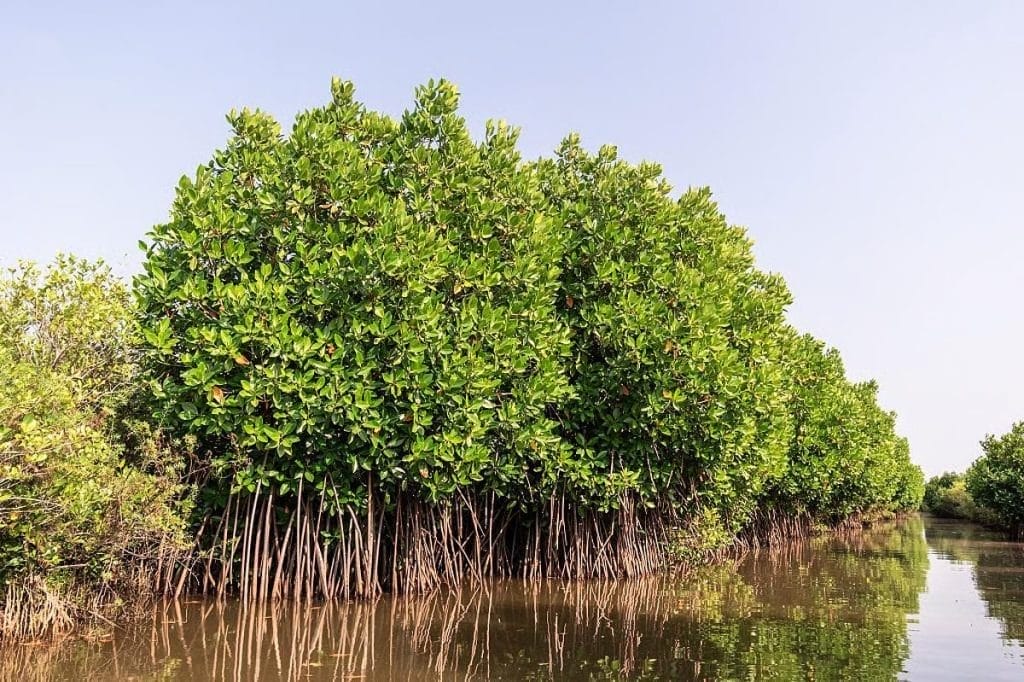
Why in News:
On World Mangrove Day (July 26), an expert has highlighted M.S. Swaminathan’s role in promoting Mangroves’ importance in the coastal ecosystem and its role in building coastal resilience against climate change and disasters.

Mangroves
- A mangrove is a salt-tolerant plant community belonging to families Rhizophoraceae, Acanthaceae, Lythraceae, Combretaceae, and Arecaceae found in tropical and subtropical intertidal regions.
- These ecosystems thrive in high-rainfall areas (1,000–3,000 mm) with temperatures ranging from 26°C to 35°C.
- Mangrove species are adapted to survive in waterlogged soils, high salinity, and frequent tidal surges.
- Some mangrove species like Avicennia are known to excrete salts via leaves and other parts.
- Respiratory/Adventitious roots/Knee roots (pneumatophores) are characteristic of many species; they project above the mud and have small openings (lenticels) through which air enters, passing through the soft spongy tissue to the roots beneath the mud.
- Viviparous mode of reproduction, where seeds germinate and develop while still attached to the parent plant, before falling to the ground or into the water as a specialized propagule.
Some prominent species found in India are:
- Avicennia officinalis – commonly found across coastal States, and salt excretion species.
- Rhizophora mucronata, also known as red mangrove.
- Sonneratia alba, also known as mangrove apple, is the state mangrove of Maharashtra.
- Heritiera fomes, also known as Sundari Species found in Sunderbans
Status of Mangroves in Indian State of Forest Report (ISFR) 2023
- As per the India State of Forest Report 2023 (ISFR-2023), India’s total mangrove cover stands at 4,991.68 sq. km, constituting 0.15% of the nation’s geographical area.
- There has been a net increase of 363.68 Sq.km (7.86%) in Mangrove cover area of the country in 2023 as compared to 2013 and net increase of 509.68 Sq.km (11.4%) between 2001 and 2023. The highest increase in 2021-23 has been in Odisha.
- West Bengal holds the largest share of the country’s mangrove forests, accounting for 42.45% of the total cover, followed by Gujarat (23.32%) and the Andaman & Nicobar Islands (12.19%).
- Gujarat has recorded an impressive increase of 253.06 sq. km in mangrove cover between 2001 and 2023, attributed to large-scale plantations, community participation, and public-private partnerships. However, as per ISFR 2023 , there has been a loss of Mangroves in Gujarat during 2021-23.
- The largest Mangrove sites are Sunderban followed by Bhiterkanika.
Note: Indonesia holds the largest area under mangrove forest globally, accounting for approximately 21% of the world’s total mangrove cover. Other countries with significant mangrove areas include Brazil, Australia, Mexico, and Nigeria. The Sundarbans, a region shared by India and Bangladesh, represents the world’s largest single patch of mangrove forest.
Significance of Mangroves
- They serve as crucial biodiversity refuges for aquatic and marine life.
- Act as bio-shields against extreme climatic events. The immense role played by mangroves during the 1999 Odisha super cyclone and the 2004 Indian Ocean tsunami, in reducing the loss of life and damage to property and natural resources is an example.
- Rural populations depend on mangroves for biomass-based livelihoods deriving timber and fisheries from it.
- A significant carbon reservoir that can help mitigate climate change. As per World Wildlife Fund mangroves store 7.5-10 times more carbon per acre than tropical forests.
- Research on the utilisation of mangrove genetic resources can help to develop new saline-tolerant crops (by transferring genes for salinity tolerance from mangroves to rice and other crops)
Regulatory Measures
India has implemented a series of stringent legal frameworks to ensure mangrove protection:
- Additional protection under the Wildlife (Protection) Act, 1972, Indian Forest Act, 1927, and Biological Diversity Act, 2002, among others.
- Coastal Regulation Zone (CRZ) Notification, 2019 under the Environment (Protection) Act, 1986, categorises mangroves as Ecologically Sensitive Areas (ESAs), restricting activities within a 50-metre buffer zone where mangrove cover exceeds 1,000 sq. m.
- Mandates compensatory replantation at a 3:1 ratio if mangroves are affected by development.
Initiatives
Mangrove Initiative for Shoreline Habitats & Tangible Incomes (MISHTI):
- Launched on 5 June 2023 to promote restoration and afforestation across 540 sq. km in 9 coastal States and 4 Union Territories.
- Implementation through convergence funding with the National Compensatory Afforestation Fund Management and Planning Authority (CAMPA).
National Coastal Mission – Conservation of Mangroves and Coral Reefs:
- Financial assistance for the conservation of 38 mangrove sites and 4 coral reef sites across the country.
- Operates on a 60:40 cost-sharing model between the Centre and States.
GCF-ECRICC Project (Green Climate Fund – Enhancing Coastal Resilience of Indian Coastal Community):
- Active since 2019 in Andhra Pradesh, Maharashtra, and Odisha.
- Aims to restore and conserve 10,575 hectares of mangroves.
- As of 2024, 3,114.29 hectares have been successfully restored.
Challenges in Mangrove conservation
Reduced Freshwater and Tidal Flows:hallenges in Mangrove conservation
- Reduced Freshwater and Tidal Flows: Construction of dams and embankments on rivers and at river mouths can reduce freshwater and tidal water inflow to mangrove areas, leading to increased salinity and affecting mangrove health and regeneration, as seen in Pichavaram, South India.
- Destruction and Fragmentation: Mangroves are cleared for various development activities. For instance, conversion to aquaculture (especially shrimp farming), expansion of rice and palm oil plantations, and infrastructure development (like dams and urban expansion) significantly reduce mangrove cover. In India, particularly in the Sundarbans and other coastal regions, these activities have led to substantial loss of mangrove forests.
- Pollution and Contamination: Agricultural runoff, industrial discharges, and improper waste disposal contaminate mangrove ecosystems, affecting their health and biodiversity.
- Climate Change and Sea Level Rise: Rising sea levels, increased frequency of extreme weather events like cyclones (e.g., Cyclone Amphan), and changes in sediment flux directly threaten mangrove survival, especially in low-lying areas like parts of the Bay of Bengal coast.
- Lack of Integrated Management: Mangrove ecosystems are often managed in isolation, without considering their interconnectedness with other coastal ecosystems like coral reefs or seagrass beds, hindering effective conservation efforts.
- Overfishing and Unsustainable Harvesting: Overfishing, including destructive practices like using push nets and trawls, can degrade mangrove habitats and reduce their ecological and economic value.
- Invasive Species: Non-native species, such as the red mangrove, can outcompete native mangrove species, altering the ecosystem’s structure and function.
- Destruction and Fragmentation: Mangroves are cleared for various development activities. For instance, conversion to aquaculture (especially shrimp farming), expansion of rice and palm oil plantations, and infrastructure development (like dams and urban expansion) significantly reduce mangrove cover. In India, particularly in the Sundarbans and other coastal regions, these activities have led to substantial loss of mangrove forests.
- Pollution and Contamination: Agricultural runoff, industrial discharges, and improper waste disposal contaminate mangrove ecosystems, affecting their health and biodiversity.
- Climate Change and Sea Level Rise: Rising sea levels, increased frequency of extreme weather events like cyclones (e.g., Cyclone Amphan), and changes in sediment flux directly threaten mangrove survival, especially in low-lying areas like parts of the Bay of Bengal coast.
- Lack of Integrated Management: Mangrove ecosystems are often managed in isolation, without considering their interconnectedness with other coastal ecosystems like coral reefs or seagrass beds, hindering effective conservation efforts.
- Overfishing and Unsustainable Harvesting: Overfishing, including destructive practices like using push nets and trawls, can degrade mangrove habitats and reduce their ecological and economic value.
- Invasive Species: Non-native species, such as the red mangrove, can outcompete native mangrove species, altering the ecosystem’s structure and function.
- Lack of Awareness and Protection: Despite their importance, mangroves are often undervalued and may lack adequate legal protection, making them vulnerable to exploitation.
Way Ahead
Strengthening Legal Frameworks
- India has established several regulations to protect mangroves. The Coastal Regulation Zone (CRZ) Notification (2019) categorizes coastal areas and restricts activities damaging to mangroves, while the Indian Forest Act, 1927, and the Wildlife Protection Act, 1972, also offer legal protection, with states like Maharashtra designating mangroves as Reserved Forests. They must be strengthened and implemented strictly.
Promoting Afforestation and Restoration:
- The Mangrove Initiative for Shoreline Habitats & Tangible Incomes (MISHTI) launched in 2023-24 aims to increase mangrove cover along the coastline and on degraded lands, as seen in Gujarat which expanded its mangrove cover significantly under this scheme.
- Techniques like direct seed sowing, raised bed plantations, and fishbone channel plantations are employed, as demonstrated in Gujarat.
Community Participation and Sustainable Livelihoods:
- Engaging local communities is crucial for long-term conservation. This can involve people’s involvement in management, awareness programs, and incentivizing sustainable practices on private and village lands.
- The “Guardians of the Coastline” project in West Bengal showcases a public-private partnership model where local women’s groups manage and benefit from eco-tourism and sustainable seafood initiatives linked to mangrove conservation, generating income and fostering stewardship.
- Karnataka’s Sindhudurg district has conserved mangroves through a multifaceted approach involving local community engagement, alternative livelihood options, and government-supported conservation initiatives.
Ecological Conservation and Scientific Research:
- Implementing eco-restoration using techniques that promote biodiversity and resilience to climate change is vital. Scientific monitoring of existing mangroves and the use of bio-restoration to revive degraded areas are also important.
- Establishing green belts and buffer zones around mangrove forests helps maintain ecological integrity.
Awareness and Education:
- Raising public awareness about the importance of mangroves through various channels like films, exhibitions, seminars, and celebrating Mangrove Conservation Day can foster a sense of responsibility towards these ecosystems.
Sustainable Tourism and Economic Alternatives:
- Promoting eco-friendly tourism in well-managed mangrove areas and developing alternative livelihoods for local communities that are compatible with mangrove conservation can provide economic incentives for protection.
International Cooperation:
- Participating in global initiatives like the Ramsar Convention and the Blue Carbon Initiative and Mangrove Alliance for Climate (MAC) for effective mangrove conservation strategies.

